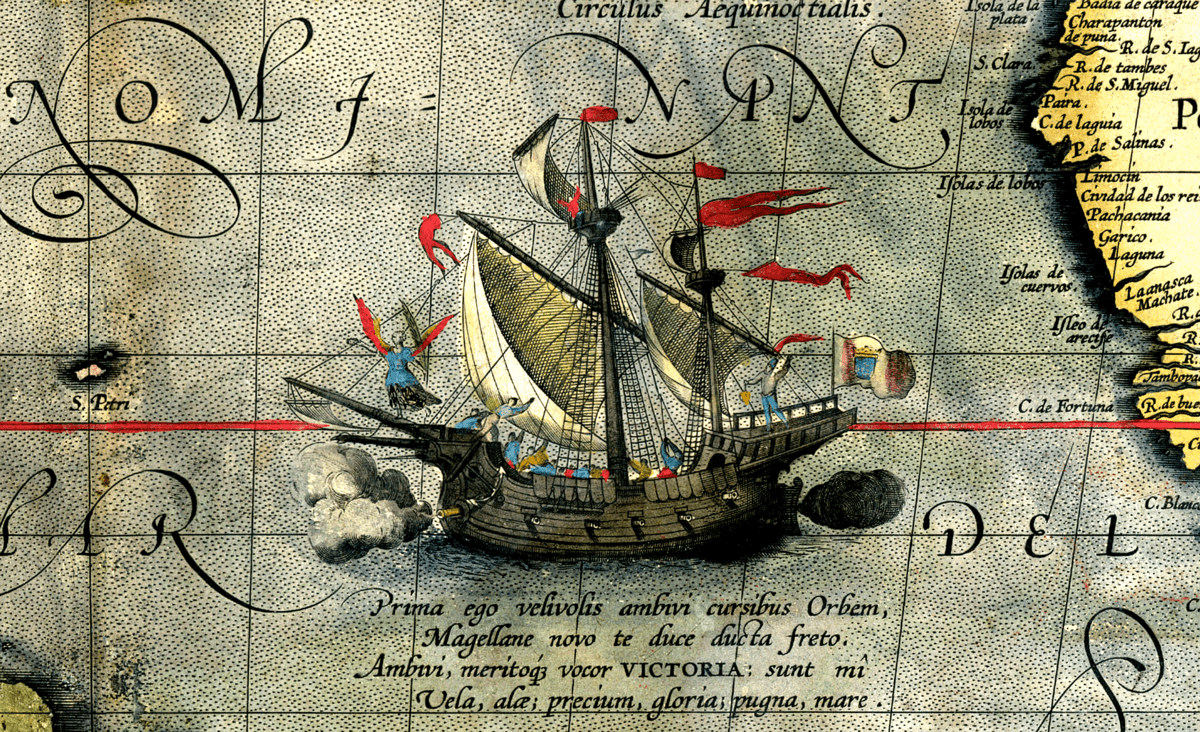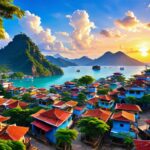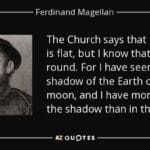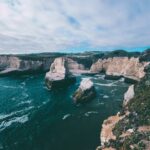Debunking the Myth: Why Magellan Never Set Foot in Trujillo
While the names “Magellan” and “Trujillo” might sound like they belong together, weaving a tale of explorers and historic cities, the reality is far more nuanced. Ferdinand Magellan, the famed Portuguese explorer who circumnavigated the globe, never actually set foot in Trujillo, Honduras. It’s a common misconception, but one that’s easily debunked when delving into the historical facts.
So, if Magellan wasn’t the one to put Trujillo on the map, who was? That honor belongs to none other than Christopher Columbus, the legendary explorer himself. In 1502, during his fourth and final voyage to the Americas, Columbus landed in Trujillo, marking the first European encounter with the mainland of what is now Honduras.
Uncovering Trujillo’s Rich History: Beyond Columbus
To define Trujillo solely by Columbus’s visit would be a disservice to the city’s captivating past. For centuries, Trujillo served as a pivotal Spanish port, acting as their central hub in the region. After Honduras gained independence, Trujillo’s importance didn’t wane. Today, this vibrant city is experiencing a remarkable resurgence, attracting visitors eager to explore its historical tapestry, relax on pristine Caribbean beaches, and immerse themselves in its lively culture.
Imagine strolling along cobblestone streets, flanked by brightly painted colonial houses, a testament to Trujillo’s rich past. Picture yourself ascending ancient fortress walls, the Caribbean breeze whipping through your hair as you gaze out at the endless ocean, conjuring images of pirate ships on the horizon. This is the allure of Trujillo – a captivating blend of history and natural beauty.
Trujillo’s cultural scene is equally vibrant. The city is home to the Garifuna people, renowned for their captivating music and dance traditions, a fusion of African and indigenous rhythms that will undoubtedly leave you mesmerized. It’s an opportunity to step into a different world, one brimming with vibrant colors, infectious music, and a welcoming warmth that envelopes you from the moment you arrive.
Unveiling the Past: Who Visited Trujillo During Columbus’s Last Voyage?
While Columbus’s arrival in Trujillo in 1502 is well-documented, the details of his crew and their experiences often remain shrouded in historical obscurity. Let’s delve into the specifics of this pivotal voyage, uncovering the lesser-known figures who accompanied Columbus and the lasting impact their arrival had on the region.
Setting the Stage:
- Timeline: August 14, 1502
- Location: Trujillo, Honduras (previously named “Punta de Caxinas” by Columbus)
- Significance: This landing marked the first time Columbus reached the mainland of Central America during his fourth and final voyage.
The Voyage:
- Purpose: Columbus’s expedition aimed to find a westward sea route to Asia (specifically China and India) in pursuit of trade.
- Ships: Four vessels formed the fleet: Santa María, El Vizcaino, El Santiago, and El Gallego.
- Key Figures:
- Christopher Columbus: Expedition leader
- Bartholomew Columbus: Columbus’s brother
- Fernando Columbus: Columbus’s 13-year-old son
- Crew: Over 140 Spaniards accompanied Columbus on this voyage, their lives and stories often overshadowed by the legacy of Columbus himself.
Trujillo: Before and After Columbus:
- Pre-Columbus: The region was already inhabited by indigenous groups, but little is known about them from written records.
- Columbus’s Arrival: He claimed the land for Spain, naming the location “Punta de Caxinas.” Recognizing the deep waters, he designated the area “Golfo de Honduras” (“Gulf of Depths”).
- Post-Columbus:
- 1524: Cristóbal de Olid, under Hernán Cortés’s orders, established a Spanish town nearby, initially called “Triunfo de la Cruz.”
- Relocation and Renaming: Due to a power struggle and a more desirable harbor, the town was relocated to Trujillo’s current location under the command of Francisco de las Casas.
Trujillo: A History Shaped by Exploration and Conflict:
- Spanish Colonial Era (16th – 18th centuries):
- Gold and Silver Trade: Trujillo became a major port for shipping precious metals mined inland.
- Pirate Attacks: Its location and wealth made it a frequent target for pirates, culminating in a massive pirate gathering in 1683.
- Shifting Capitals: Due to its vulnerability to attacks, the capital of Honduras moved from Trujillo to Comayagua and eventually to Tegucigalpa.
- Post-Independence (1821 – present):
- William Walker Incident (1860): Trujillo was briefly captured by the American mercenary during his attempt to retake Nicaragua.
- Economic Revival: The late 19th century saw Trujillo prosper as a trading hub, particularly with the rise of the banana industry.
Unveiling the Untold Stories:
To truly understand the significance of Columbus’s landing in Trujillo, we must move beyond the well-trodden paths of traditional historical narratives. By delving into the lives of the 140+ Spaniards who accompanied Columbus, we can shed light on the often-overlooked human element of the voyage. Who were these individuals? What were their motivations for embarking on such a perilous journey? What challenges did they face, and how did their experiences shape their perceptions of the New World?
Furthermore, it’s crucial to acknowledge the indigenous communities who called Trujillo home long before Columbus’s ships appeared on the horizon. While written records may be scarce, oral histories, archaeological evidence, and ongoing research can provide invaluable insights into their lives, cultures, and the impact of European arrival.
By exploring these untapped areas of history, we can craft a more nuanced and comprehensive narrative of Trujillo’s past. This approach not only enriches our understanding of this pivotal moment in history but also challenges us to reconsider the dominant narratives that have shaped our perceptions of exploration, colonialism, and cultural exchange.
Analyzing the Battle of Mactan: Outperforming the Competition
While Ferdinand Magellan might not have set foot in Trujillo, his ill-fated expedition to the Philippines led to a clash of cultures and a battle that would forever shape the course of history.
On April 27, 1521, on the shores of Mactan Island, Magellan and his men, armed with muskets and cannons, faced off against Lapu-Lapu, a local chieftain, and his warriors, who fought with spears, bows, and arrows. Confident in their superior weaponry, the Spanish forces underestimated the strategic brilliance and unwavering courage of Lapu-Lapu and his forces.
The Battle of Mactan, a clash of seemingly unevenly matched opponents, resulted in a decisive victory for Lapu-Lapu and his warriors. Magellan himself was slain in the fight, marking an unexpected end to his ambition of claiming the Philippines for Spain.
This battle, a pivotal moment in history, shattered the illusion of European invincibility and ignited a spark of resistance that would echo through the centuries. It serves as a testament to the enduring power of courage, determination, and the fierce defense of one’s homeland.
The Significance of the Battle of Mactan:
- David vs. Goliath: The Battle of Mactan stands as a powerful symbol of resistance against overwhelming odds.
- Turning Point in History: This victory marked the first successful indigenous resistance against European colonialism in the Philippines, delaying Spanish colonization by over four decades.
- A Clash of Worlds: More than just a military conflict, the Battle of Mactan represented a clash of cultures, ideologies, and military strategies, with profound consequences for both the Philippines and global exploration.
Unique Insights & Untapped Potential:
To truly grasp the significance of the Battle of Mactan, we need to delve deeper, exploring the nuances of military strategy, cultural misunderstandings, and the often-overlooked perspectives of the victors.
- Military Strategy: How did Lapu-Lapu, despite his seemingly inferior weaponry, outmaneuver and defeat Magellan’s forces? Analyzing the contrasting battle tactics and the strategic use of terrain can provide valuable insights.
- Cultural Misunderstandings: Were there missed opportunities for diplomacy or peaceful co-existence? Could cultural differences and misinterpretations have contributed to the escalation of conflict?
- Lapu-Lapu’s Perspective: While historical accounts often focus on Magellan, exploring Lapu-Lapu’s motivations, leadership, and the oral histories passed down through generations can offer a more balanced perspective on the battle.
By weaving together these threads of history, military strategy, and cultural analysis, we can create a more nuanced and captivating narrative of the Battle of Mactan, one that recognizes the courage and resilience of those who fought for their freedom and the enduring legacy of their victory.
Ferdinand Magellan: The Explorer Who Remade the World
Ferdinand Magellan, a name synonymous with exploration and adventure, continues to captivate our imaginations centuries after his fateful voyage. Born in Portugal in 1480, Magellan’s life was marked by ambition, a thirst for knowledge, and an unwavering determination to push the boundaries of the known world. Yet, his journey was not one of solitary glory but a testament to the collective efforts of skilled navigators, cartographers, and adventurers who dared to challenge the limits of human understanding.
Magellan’s Early Life and the Lure of the Spice Trade:
Magellan’s early life hinted at the adventurous spirit that would come to define his legacy. After serving in the Portuguese fleet and gaining invaluable experience in naval warfare and navigation, he became disillusioned with the lack of recognition from the Portuguese crown. Seeking patronage for his ambitious plans, Magellan set his sights on Spain, where King Charles I, eager to challenge Portuguese dominance in the lucrative spice trade, agreed to finance his audacious expedition.
The Voyage That Changed the World:
In 1519, Magellan embarked on a voyage that would forever alter the course of history. Leading a fleet of five ships and a diverse crew, he set sail from Spain with the goal of finding a westward route to the Spice Islands, a journey fraught with peril, mutiny, and unimaginable hardship.
From the treacherous waters of the Strait of Magellan, now bearing his name, to the vast expanse of the Pacific Ocean, which he named “Mar Pacifico” for its deceptive calmness, Magellan and his crew faced storms, starvation, and the ever-present threat of disease. The voyage tested the limits of human endurance, yet amidst these trials, Magellan’s determination never wavered.
A Legacy Forged in Exploration and Sacrifice:
While Magellan’s life was tragically cut short in 1521 during a battle in the Philippines, his expedition achieved what many thought impossible: the first circumnavigation of the globe. This remarkable feat, completed by Juan Sebastián Elcano, solidified Magellan’s place in history and ushered in a new era of exploration, global trade, and unfortunately, colonialism.
Unraveling the Complexities of Magellan’s Legacy:
Magellan’s voyage, while a testament to human courage and ingenuity, also casts a long shadow. His arrival in the Philippines marked the beginning of Spanish colonization, a chapter in history marred by violence, exploitation, and cultural assimilation.
To truly understand the impact of Magellan’s explorations, we must grapple with these complexities, recognizing both the advancements in navigation, cartography, and global understanding that his voyage ushered in, as well as the lasting consequences of colonialism that continue to shape our world today.
Exploring the Untold Stories:
Magellan’s journey was not a solitary endeavor. Hundreds of men, hailing from diverse backgrounds, embarked on this perilous voyage. Their stories, often overshadowed by Magellan’s own, offer a glimpse into the human cost of exploration, the challenges faced, and the remarkable resilience displayed.
Furthermore, by incorporating the perspectives of the indigenous populations Magellan encountered, we can gain a more nuanced understanding of the impact of his arrival. Through oral histories, archaeological evidence, and ongoing research, we can shed light on the cultural exchanges, both peaceful and fraught with tension, that transpired during this pivotal period.
Unveiling the Story of Magellan’s Voyage: A Comprehensive Analysis
In 1519, Ferdinand Magellan set sail from Spain with a fleet of five ships, embarking on a perilous journey that would forever alter humanity’s perception of the world. What began as a quest to find a westward route to the Spice Islands evolved into a grueling test of human endurance, a testament to the spirit of exploration that drove these intrepid adventurers.
The Genesis of a Daring Expedition (1518-1519):
Motivated by the desire to challenge Portuguese dominance in the lucrative spice trade, King Charles I of Spain embraced Magellan’s ambitious proposal for a westward expedition. Five ships – the Trinidad, San Antonio, Concepción, Victoria, and Santiago – were outfitted for the journey, their decks teeming with a diverse crew of approximately 270 men, each carrying their own hopes, dreams, and fears into the unknown.
Across the Atlantic and into Uncharted Waters (1519-1520):
The expedition’s departure from Spain in September of 1519 marked the beginning of a journey filled with both wonder and hardship. The initial leg, crossing the Atlantic, presented its share of challenges, but it was the search for a passage through South America that would prove most daunting. After months of exploration, facing treacherous currents, unpredictable weather, and dwindling supplies, Magellan’s persistence paid off with the discovery of the passage that would later bear his name: the Strait of Magellan.
Trials, Tribulations, and the Vast Pacific (1520-1521):
Emerging from the Strait of Magellan into the vastness of the Pacific Ocean, Magellan and his crew faced a new set of challenges. The ocean, deceptively calm, presented unforeseen difficulties. Supplies dwindled, scurvy ravaged the crew, and the sheer immensity of the Pacific tested even the most seasoned sailor’s resolve.
The Philippines, Magellan’s Demise, and a New Leader (1521):
Reaching the Philippines in 1521, Magellan, seeking to claim these new lands for Spain and spread Christianity, became entangled in local conflicts. On April 27, 1521, during the Battle of Mactan, Magellan’s life was cut short, marking an abrupt end to his personal quest.
Amidst the turmoil of Magellan’s death and the challenges that followed, Juan Sebastián Elcano, a Basque navigator, emerged as the leader, taking command of the Victoria and guiding the remnants of the expedition towards their ultimate goal.
Elcano’s Determination: Completing the Unthinkable (1521-1522):
Under Elcano’s leadership, the expedition, now reduced to two ships, finally reached the Spice Islands, accomplishing a feat that had seemed all but impossible. The return journey, however, proved equally perilous. Facing hostile Portuguese forces and navigating uncharted waters, Elcano’s determination and navigational skills were pushed to their limits.
Triumphant Return and a Legacy Forged (1522 – Present):
On September 6, 1522, the Victoria, the sole surviving ship of the expedition, limped back into a Spanish port, carrying Elcano and the 17 surviving crew members. Their arrival marked a pivotal moment in history. The first circumnavigation of the globe had been achieved.
A Legacy of Exploration and Its Complexities:
Magellan’s expedition, though fraught with hardship and loss, fundamentally changed our understanding of the world. It proved the Earth’s sphericity, revealed the true vastness of the Pacific Ocean, and ushered in a new era of global exploration, trade, and unfortunately, colonialism.
To truly honor the legacy of this momentous voyage, we must engage with its complexities. While celebrating the spirit of adventure and the pursuit of knowledge that fueled these explorations, we must also critically examine the impact on the indigenous populations encountered and the long-lasting consequences of colonialism that followed.
Uncovering the Human Stories:
By delving into the individual accounts of the crew, the challenges they faced, the cultural exchanges that transpired, and the lasting impact on the indigenous populations they encountered, we can breathe life into the historical narrative. Through meticulous research, incorporating primary sources like Antonio Pigafetta’s firsthand account, we can gain a more nuanced and empathetic understanding of this pivotal chapter in human history.
For further exploration of captivating historical events and figures, check out these articles:
- Uncover the enigmatic world of space travel and the enigmatic prophecies of Edgar Cayce in the ancient aliens – edgar cayce: the sleeping prophet.
- Dive into the compelling story of the Prophet Muhammad, shaping the world’s history in muhammad legacy of a prophet frontline.
- Witness the iconic sidekicks of 1950s television in sidekick of 1950s tv.
- Unveiling Bernhard Caesar Einstein’s Scientific Achievements: A Legacy in Engineering - July 15, 2025
- Uncover who is Jerry McSorley: CEO, Family Man, Business Success Story - July 15, 2025
- Discover Bernhard Caesar Einstein’s Scientific Contributions: Unveiling a Legacy Beyond Einstein - July 15, 2025















